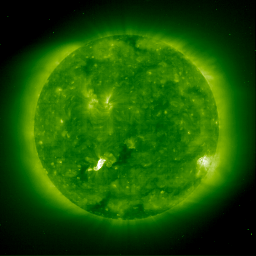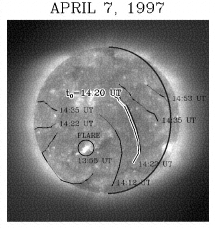Reverberations of April 7, 1997
Science Nugget: August 24, 2001
Introduction
Sometimes the initial look at a given phenomenon doesn't reveal all of
its subtleties.
This may be hard medicine for a writer of science nuggets to swallow, since
we're always having to meet our schedule.
However it is also nice to see the information accumulating, and this
nugget reviews several pieces of work on one of the first really nice
flare/CME events of the current solar maximum: April 7, 1997.
Multifarious observations
Sigmoid -> arcade: Click on the
link to the left to see Nariaki Nitta's
comprehensive look at this
phenomenon, as originally described by
Sterling for the April 7 event.
Surprisingly this initial discovery of a coronal sigmoid disappearing
(see left below) was joined by the discovery (see right below)
that the sigmoid sometimes appears instead!
One speculation would be that the coronal structure at the heart of these
flare/CME events is pretty stable and does not change as catastrophically
as the middle and upper corona.
Note that the illustrations just below don't refer to April 7, but to other
examples.
An EIT wave: our April 7 event was
one of the first for which the "EIT wave" phenomenon
could be well observed.
Click on the title here or the image below for a movie - reload it if you
want to see it again, because it does not loop (sorry).
These waves are either the direct manifestation of the CME liftoff, or else
they may be signatures of global MHD shock fronts.
Probably, in this case, the former.

Delayed particles: flare/CME
events release high-energy particles into the interplanetary medium, and
this event was one used by
Krucker et al. to discover late releases.
Left below, particle counting rates; middle below, analysis of velocity
dispersion; right below, the inference (white lines) regarding the location
at which the EIT wave somehow triggered the proton injection.
Well, this is pretty technical, but it is wonderful to see how we are beginning
to use particles
(as well as photons) to learn what's happening in the solar
corona.
A "termination shock"? Finally, a recent
report by Aurass, Vrsnak, and Mann (not yet published) points out a quite
remarkable feature in the meter-wave spectrum of this event.
They interpret it in terms of the standard reconnection cartoon (left
below), which envisions a termination shock for the reconnection
outflow.
This makes the feature indicated in the middle plot below, according to the
authors.
The rightmost panel just puts it all in perspective, with the meter-wave
images from the
Nancay radioheliograph placing the new phenomenon precisely where the
cartoon envisioned.
Unfortunately it does not occur anywhere near when the cartoon suggests,
but about an hour later.
This discrepancy has our pundits stroking their greybeards in puzzlement.
Alas, no theory is perfect!
Last words
One of the reasons this event continues to interest us is its lack of
competition.
Nowadays, as a survey of these nuggets will show you, there are many flare
events.
We are currently at the maximum phase of
the solar cycle.
This may cause problems of confusion.
Such problems don't worry us so much for the April 7, 1997 event, which
happened just at the end of the minimum of solar activity, when the corona
was still quite empty.
"More than four years ago" defines ancient history in this sort of research,
well enough to make this a kind of
Rosetta stone, it seems.
August 24, 2001
H. Hudson
<hudson@isass1.solar.isas.ac.jp>.









